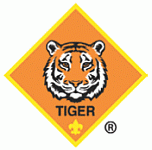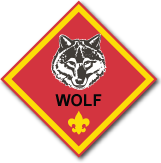About the Pack’s Structure
Like every effective organization, Cub Scout Packs have a structure. Understanding this structure and how it works will increase your son’s enjoyment of the program (and leave the parent far less confused).
Dens
Groups of 6 to 10 Cub Scouts meet 2-3 times a month together as a Den. Each Den is led by a Den Leader and an Assistant Den Leader. A older Scout from a local ScoutsBSA Troop, known as a Den Chief, may also work with your child’s den.
Dens are organized by age groups. Cub Scouts work toward a specific rank during each year in the Pack. Ultimately, they work towards the Arrow of Light award, the highest award in Cub Scouting. We have one or more Dens at each rank:
 |
Lion Cub: Kindergartners work toward the Lion badge. The Lion badge is earned by completing five adventures. Outside of the requirements, Lion Cub Scouts can also complete any number of seven elective adventures of their den’s or family’s choosing. |
 |
Bobcat: All youth beginning in first grade will first work on their Bobcat badge to complete the Cub Scout joining requirements, which include knowing and reciting the Scout Oath and Scout Law and knowing the Cub Scout motto and salute. Once the Bobcat badge requirements have been completed, the Cub Scout will continue with the age appropriate program. |
 |
Tiger: The Tiger program is for first graders and their adult partners. Tiger Cub Scouts must complete six required adventures and one of thirteen elective adventures with their den or family, as well as completing age-specific cyber-safety exercises (called the Cyber Chip) and exercises to help prevent child abuse with their family. The Cyber Chip and abuse prevention requirements must be completed annually. The remaining elective adventures may be completed throughout the rest of the school year. |
 |
Wolf: The Wolf program is for second graders. Wolf Cub Scouts must complete six required adventures and one of thirteen elective adventures with their den or family, as well as completing age-specific cyber-safety exercises (called the Cyber Chip) and exercises to help prevent child abuse with their family. The Cyber Chip and abuse prevention requirements must be completed annually. The remaining elective adventures may be completed throughout the rest of the school year. |
 |
Bear: The Bear rank is for third graders. Bear Cub Scouts must complete six required adventures and one of thirteen elective adventures with their den or family, as well as completing age-specific cyber-safety exercises (called the Cyber Chip) and exercises to help prevent child abuse with their family. The Cyber Chip and abuse prevention requirements must be completed annually. The remaining elective adventures may be completed throughout the rest of the school year. |
 |
Webelos: This program is for fourth and fifth graders. WEBELOS stands for “WE’ll BE LOyal Scouts”. A youth may begin working on the Webelos badge as soon as they join a Webelos den. This is the first step in their transition from the Webelos den to the ScoutsBSA troop. As they complete the requirements found in the Webelos Scout Book, they will work on activity badges, attend meetings, and become familiar with the ScoutsBSA requirements—all leading to the Arrow of Light Award. |
The Pack
The Pack consists of the Dens and their Families. Pack 106 meets monthly for a Pack meeting and also schedules special activities throughout the year. The Pack serves as a vehicle for parent and family involvement in scouting.
The Committee
The Pack Committee consists of volunteer adults who are charged with managing the Pack and its programs. Parents are encouraged to volunteer to serve on the Committee and attend regular meetings. Meeting dates are shown on the Pack Calendar. The Committee Chairperson and the Cubmaster lead the group in planning and organizing the Pack program. The Committee is also responsible for maintaining Pack funds and planning its budget.
For a more in depth view, please visit the How Cub Scouting is Organized page on Scouting.org
